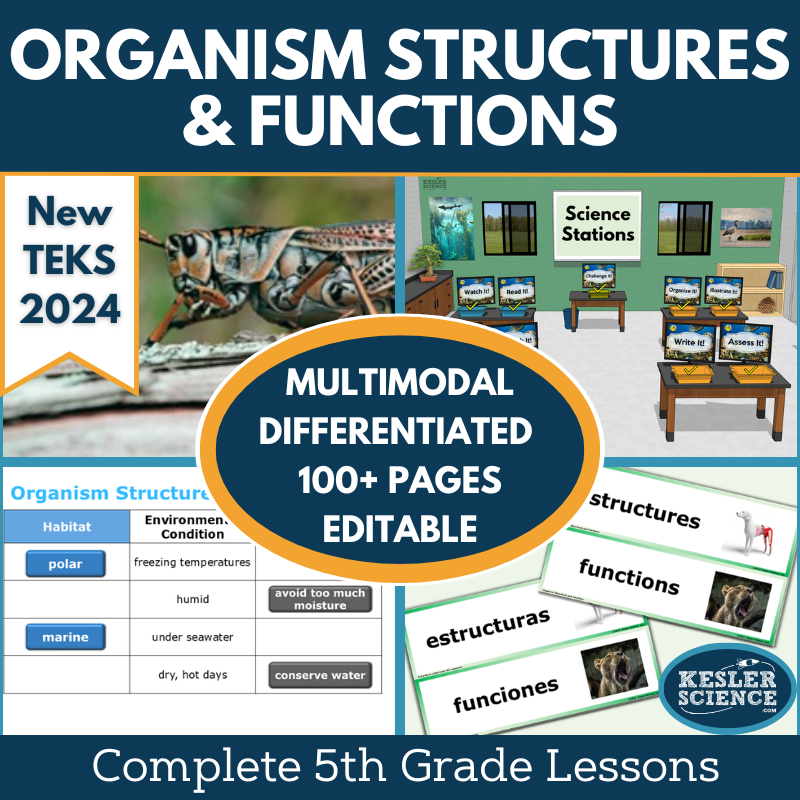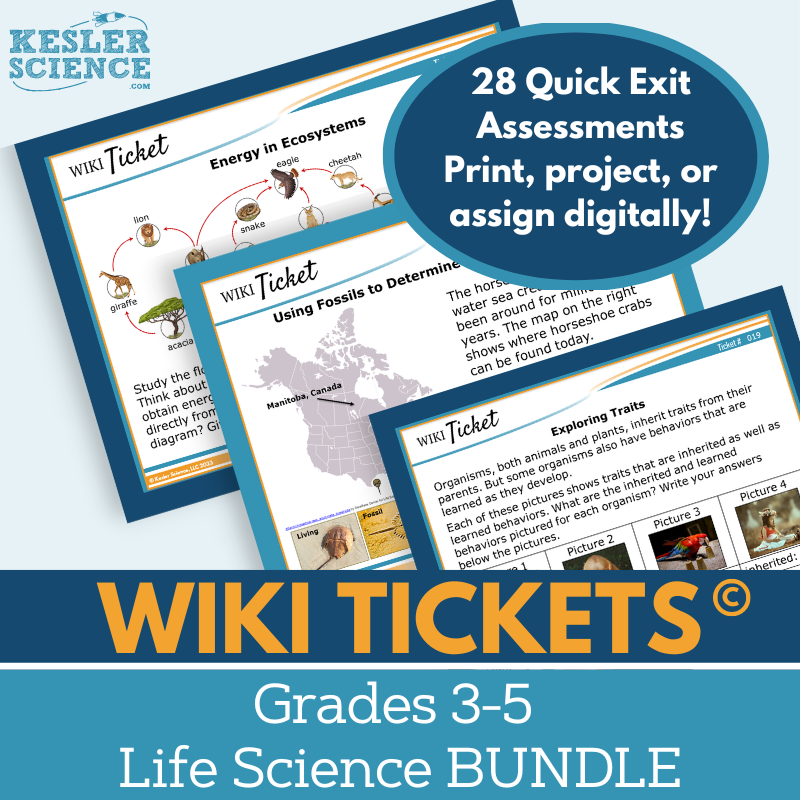Organism Structures & Functions Activities for 5th Grade Science
The Kesler Science Organism Structures & Functions Unit is designed for 5th grade students to explore how the structures and functions of different species help them survive in their environments. The resources below will give students a comprehensive understanding of organism structures and functions. All of the following materials are also included in the Kesler Science Membership.
The Kesler Science Organism Structures & Functions Unit is designed for 5th grade students to analyze the structures and functions of different species and how these adaptations help organisms survive in the same environment. Aligned with TEKS 5.13A, the lesson includes editable PowerPoints, worksheets, assessment, choice projects, and differentiated materials for varied learning needs, all with minimal prep required. The unit follows the 5E Model, with engaging activities for each phase:
- Engagement: Objectives, vocabulary, and class activities, including student discussions and common misconceptions.
- Exploration: A student-led station lab with nine stations offering multimodal learning (hands-on experiments, reading passages, videos, research tasks, and activities to organize, write, illustrate, and assess understanding).
- Explanation: Editable PowerPoints and interactive notebooks in English and Spanish for differentiated instruction.
- Elaboration: Student-choice projects to extend learning.
- Evaluation: STAAR 2.0-aligned assessment questions and worksheets for review and practice.
This lesson is flexible for both in-person and virtual classrooms, providing a comprehensive and engaging learning experience.
The Kesler Science Organism Structures & Functions Unit is designed for 5th grade students to analyze the structures and functions of different species and how these adaptations help organisms survive in the same environment. Aligned with TEKS 5.13A, the lesson includes editable PowerPoints, worksheets, assessment, choice projects, and differentiated materials for varied learning needs, all with minimal prep required. The unit follows the 5E Model, with engaging activities for each phase:
- Engagement: Objectives, vocabulary, and class activities, including student discussions and common misconceptions.
- Exploration: A student-led station lab with nine stations offering multimodal learning (hands-on experiments, reading passages, videos, research tasks, and activities to organize, write, illustrate, and assess understanding).
- Explanation: Editable PowerPoints and interactive notebooks in English and Spanish for differentiated instruction.
- Elaboration: Student-choice projects to extend learning.
- Evaluation: STAAR 2.0-aligned assessment questions and worksheets for review and practice.
This lesson is flexible for both in-person and virtual classrooms, providing a comprehensive and engaging learning experience.
This student-led station lab, aligned with TEKS 5.13A, engages 5th-grade students in exploring the structures and functions of organisms and how these adaptations help them survive in various environments. Through nine differentiated stations, students analyze how different species thrive in their ecosystems. The activities include multimodal approaches like videos, readings, and hands-on tasks that allow students to take control of their learning while teachers facilitate the process.
Stations cover a range of tasks, from exploring new concepts and watching videos to researching specific species. Output stations encourage students to organize, illustrate, and communicate their understanding through writing and interactive tasks. With an additional challenge station for early finishers, this flexible resource is ideal for both in-person and virtual learning, offering a comprehensive and engaging way for students to master the content.
This student-led station lab, aligned with TEKS 5.13A, engages 5th-grade students in exploring the structures and functions of organisms and how these adaptations help them survive in various environments. Through nine differentiated stations, students analyze how different species thrive in their ecosystems. The activities include multimodal approaches like videos, readings, and hands-on tasks that allow students to take control of their learning while teachers facilitate the process.
Stations cover a range of tasks, from exploring new concepts and watching videos to researching specific species. Output stations encourage students to organize, illustrate, and communicate their understanding through writing and interactive tasks. With an additional challenge station for early finishers, this flexible resource is ideal for both in-person and virtual learning, offering a comprehensive and engaging way for students to master the content.
The Organism Structures & Functions Student Choice Projects align with the 2021 TEKS life science standard 5.13A. These projects allow 5th grade students to select a project that suits their preferred output style, with six student-led options plus a “design your own” project. A grading rubric is included for assessments by teachers, peers, or students themselves.
The projects are flexible and multimodal, offering creative ways for students to demonstrate their understanding. Teachers can modify the rubric to fit their grading needs, and the resources support various differentiation options, including a modified version for students needing remediation and more challenging options for advanced learners. The projects use standard classroom supplies such as paper, markers, and scissors, with many options available for digital completion.
The Organism Structures & Functions Student Choice Projects align with the 2021 TEKS life science standard 5.13A. These projects allow 5th grade students to select a project that suits their preferred output style, with six student-led options plus a “design your own” project. A grading rubric is included for assessments by teachers, peers, or students themselves.
The projects are flexible and multimodal, offering creative ways for students to demonstrate their understanding. Teachers can modify the rubric to fit their grading needs, and the resources support various differentiation options, including a modified version for students needing remediation and more challenging options for advanced learners. The projects use standard classroom supplies such as paper, markers, and scissors, with many options available for digital completion.
The Plant Structures/Animal Behaviors Science Writing Prompt Activity engages middle school students in creative journal entries that test their understanding of life science. Aligned with the MS LS1-4 standard, this activity encourages students to use scientific reasoning to explore how animal behaviors and plant structures affect reproduction. It’s designed to support both in-person and virtual learning.
The resource includes teacher directions, a projection version for easy class sharing, and full-sized or half-sheet handouts with prompts, self-checks, and pre-writing strategies. A digital interactive version is also available for Google Slides or PowerPoint, ideal for remote or in-person learners. This low-prep, student-centered activity is perfect for cross-curricular use, formative assessments, student projects, early finishers, and extra credit.
These activities can be displayed on bulletin boards or compiled into an anthology, making them a versatile addition to any classroom.
The Plant Structures/Animal Behaviors Science Writing Prompt Activity engages middle school students in creative journal entries that test their understanding of life science. Aligned with the MS LS1-4 standard, this activity encourages students to use scientific reasoning to explore how animal behaviors and plant structures affect reproduction. It’s designed to support both in-person and virtual learning.
The resource includes teacher directions, a projection version for easy class sharing, and full-sized or half-sheet handouts with prompts, self-checks, and pre-writing strategies. A digital interactive version is also available for Google Slides or PowerPoint, ideal for remote or in-person learners. This low-prep, student-centered activity is perfect for cross-curricular use, formative assessments, student projects, early finishers, and extra credit.
These activities can be displayed on bulletin boards or compiled into an anthology, making them a versatile addition to any classroom.
The Life Science Set of WIKI Tickets© offers 28 formative assessments designed for 3rd-5th grade science students. Each assessment comes in five formats: a full-screen version for projection, three handout sizes (full, split, and quarter-page), and an interactive digital version compatible with PowerPoint and Google Slides. Aligned with NGSS and TEKS standards, these assessments cover a wide range of topics, from animal groups and ecosystems to energy flow, plant growth, and inherited traits.
Each standard is addressed with at least one ticket, with some topics having multiple options. The set includes a bonus table of contents to help you navigate the alignment. The assessments are versatile for both in-person and virtual learning environments. They can be used as exit tickets, bellringers, or quick checks to gauge student understanding, offering a colorful and engaging way to track progress.
The Life Science Set of WIKI Tickets© offers 28 formative assessments designed for 3rd-5th grade science students. Each assessment comes in five formats: a full-screen version for projection, three handout sizes (full, split, and quarter-page), and an interactive digital version compatible with PowerPoint and Google Slides. Aligned with NGSS and TEKS standards, these assessments cover a wide range of topics, from animal groups and ecosystems to energy flow, plant growth, and inherited traits.
Each standard is addressed with at least one ticket, with some topics having multiple options. The set includes a bonus table of contents to help you navigate the alignment. The assessments are versatile for both in-person and virtual learning environments. They can be used as exit tickets, bellringers, or quick checks to gauge student understanding, offering a colorful and engaging way to track progress.
Year-Round Resources
These year-round activities will increase your students' understanding of many middle school science topics. All of these activities are also included in the Kesler Science Membership.
Visual Data & Graphing
You're not alone if your students struggle with understanding graphs, charts, and tables. It's a skill that takes an enormous amount of practice. This resource will help students build a strong foundation in analyzing data and creating their own data visualizations.
Bell Ringers and Warm-Ups
These middle school science bell ringers are an excellent way to engage your students as soon as they walk into your classroom. This comprehensive FULL YEAR resource includes everything you need to start off each science class with an interesting warm-up activity.
Review Board Games
Each game board has been carefully designed to keep students engaged. There are 10 different action spaces on each board and dozens of question cards. All of the actions are related to science concepts and keep the students motivated throughout the game.
Each game is ready to play. Simply print out the board and the cards and let the students enjoy reviewing nine different units.
Essential Questions and Standards
Below are the essential questions and standards associated with the lessons and activities included in the atoms unit. This topic is only one of more than 100 middle school science topics included in the Kesler Science Membership.
-
How do the different structures of plants and animals help them to survive?
-
Do organisms in the same environment have identical structures to accomplish the functions needed to help them survive?
-
TEKS Science - 5.13A Organism Structures & Functions
Kesler Science Membership
Imagine never having to search for another middle school science lesson again. The membership gives you access to ALL of the Kesler Science products in one place (Yes, including everything above).
Say goodbye to long hours of lesson prep.











